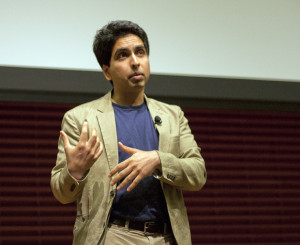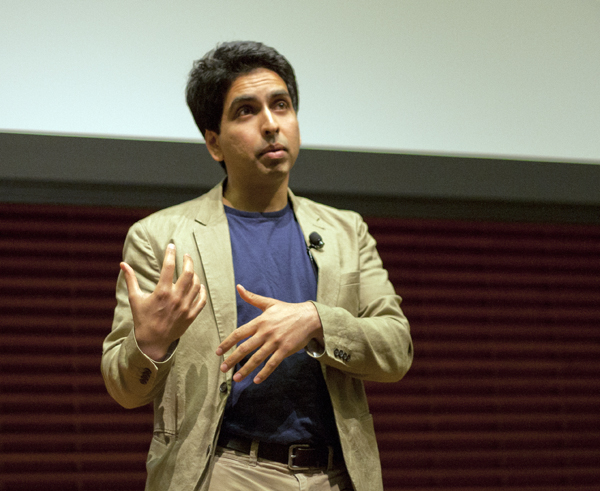This is the first in a series of two articles. This article will highlight the challenges, according to Sal Khan, that higher education faces, and the second will outline the solutions he envisions.
In a modest, unassuming office in Mountain View, Calif., a small group of Khan Academy employees recently celebrated the online education platform’s 200 millionth lesson. The workspaces are simple, cluttered even, and in them, a small group of designers, computer scientists and developers are reinventing education. At the forefront is Salman Khan.

Sal, as he is affectionately known, is somewhat of a cult celebrity among those who actively use Khan Academy: educators desiring to push the limits of contemporary pedagogy, or simply those who find the clarity and ease of the platform’s online lectures refreshing and even entertaining.
His rise to prominence in online education was serendipitous. Teaching his niece over a webcam, Khan began uploading his tutoring sessions to YouTube and his videos caught the attention of millions, so he quit his day job as a hedge fund analyst and founded Khan Academy.
That was 2009. Now, Khan is eyeing a fundamental rethinking of K-12 education, as outlined in his now-famous TED talk, media appearances, and, most recently, through his new book, “The One World Schoolhouse.” However, Khan also has higher education in his sights, and is animated when our discussion of the topic begins.
Education’s Prussian Problem
“The Prussian model, as the name implies, comes from 18th and 19th century Prussia,” Khan said, somewhat obviously. But what is not obvious is how this pedagogic model came to become the world’s dominant educational vehicle.
“They asked themselves, ‘How can we have mass education?’- a very egalitarian idea,” Khan said. “It was the early stage of the industrial revolution, so they asked themselves, ‘How do we create mass anything?’”
“Well, we set up an assembly line and have products go through at a set pace through different stations and we sift the product out at the end,” he said.
“Let’s apply that idea to students,” he said was their thought, and the prevalence of this mode of teaching means reflecting on it can be difficult.
“We’ve all grown up in this model and so it’s hard for us to imagine that this is so constructed or unnatural…Everyone has the Prussian model now. It’s even at the university level.”
Learners are compartmentalized by less-than-sensible criteria, Sal explained. He argues that this has led to various structural learning disadvantages among students.
Learners are batched together by age, sent to classes for an equal duration of time where their curriculums are rigidly set. They are all taught the material at the same pace, and “knowledge is sprayed on the student usually in the form of a lecture.”
“It does hurt learning, for the same reason it hurts learning in K-12,” Khan said. “The Prussian model ensures that you will have gaps in your knowledge.”
“We’ve all experienced getting to a senior math class and think, well, I should have paid more attention to [previous] classes…Because this model is based on everyone moving at the same pace on an assembly line, you have no way to fix those gaps.”
The existence and ubiquity of this way of learning was perhaps necessary at the time it was created, but now technology provides us with ways to upend this traditional model with something that may be far more efficient and far more productive for learners.
However, its dominance has left it prone to inertia and lethargy, which, according to Khan, prevents learners from fully engaging their educational experience.
Teachers teach; do students learn?
“Let’s imagine a world without computers and imagine a typical classroom, K-12. You’ve got 30 kids in a room, most of the time they’re relatively passive and a lecture is being applied to them.
“It’s a passive lecture, and at the university level, it will often go to 300 people in a classroom,” Khan said. “That is fundamentally a dehumanizing process, to be in a room with N other human beings and not interact with them. Your human instinct is to talk to them, to ask questions, for others to ask you questions, to laugh, to joke, to interact.”
The manner in which we are taught is very different, argues Khan, from how human beings actually learn.
“We’re at the early stages of our own research. I think that the general narrative is that people learn when it’s active and when it’s at their own pace…as opposed to passive, and at somebody else’s pace,” he said. “And this is not how it aligns at most universities, especially the large-scale freshman calculus, the typical college course.”
This misalignment is a key hindrance for learners as it inhibits their learning potential. And, as Khan explained, the problem is self-reinforcing because of grades and credentials that are not particularly useful or meaningful.
“Then students are graded, literally like eggs, where you’re an ‘A’ egg or a ‘B’ egg or a ‘C’ egg, and even though you’ve identified a weakness that probably be improved upon, it’s viewed as more of an inherent flaw in you and you’re put on the next stage of the process.”
What does Goldman Sachs want?
“Go ask the bottom 50 percent of income strata, ‘Why are you going to college?’ They’re going to be pretty clear…
It’s about them being able to be productive and being able to support themselves and their families,” Khan said.
Khan argues that the importance of future employment is so large and potentially so motivating that it skews a number of college decisions.
“There’s been this weird discomfort about this, but the reality is a lot of the reason a kid shows up at Stanford or Harvard is…to work for Goldman Sachs,” he said.
Students hold instrumental notions about their educations, such as: “Goldman Sachs only recruits at eight universities, even though I’ve gotten a full ride at university nine, I care about what Goldman Sachs thinks, I care about what McKinsey thinks, I care about what Google thinks.”
He calls this a “market failure” in learning.
“There’s a market failure going on…And the signaling system has broken down,” Khan said, arguing that skills and opportunities are not being matched because of arbitrary job requirements that do not take into consideration the relevant part of a candidates’ knowledge base.
He also maintains that college diplomas do not carry the right information for employers to make informed decisions about potential jobs candidates.
“There are students at Stanford who are off the charts on one dimension that Google would really value but they bombed a course in another dimension and because of that they don’t make the resume screening,” he said.
Khan says a possible solution could be a closer partnership with the private sector and the establishment of specific micro-credentials that would increase the information between students and employers, and would level the playing field for students not from brand-name universities.
Future thoughts
“At MIT, at Harvard, it was, just to kind of show up and be surrounded by people who were just really impressive people, you’re surrounded by faculty who have done things you didn’t think human beings could do, you meet alumni that are starting businesses and leading things,” he said, remembering his time at the two universities from which he earned a cumulative four degrees.
“I learned from my peers and I learned from doing projects and I learned from mentors, but I learned very little from lectures, and I’ve talked about how little I attended them.”
Khan is somebody who understands how tremendous the value of an education is and yet is motivated to eliminate what he perceives as its most egregious inefficiencies.
And the numbers back him up. Time magazine’s recent higher education spread included a survey that yielded disheartening results.
Eighty percent of the general public believes that “at many colleges, the education students receive is not worth what they pay for it.” And 83 percent believe that “at many colleges, there is too much of a disconnect between the courses offered and student’s career goals.”
With student debt standing at $956 billion, according to Federal Reserve Bank of New York’s Quarterly Report on Household Debt and Credit, the problem is serious.
Khan is committed to new forms of pedagogy, instruction, different emphases in the classroom and a fundamental reorganization of how we learn and what we gain from learning. He and his team are working to make this vision a reality.
